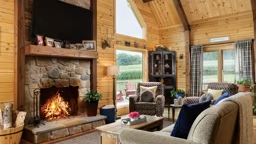
Log home owners know the magic of an evening outdoors, especially in a scenic locale. Truly, it fuels the soul, especially if you’ve gathered around the blaze with friends and family. However, not everyone has a dedicated firepit area (note to your DIY self: put that on your to-do list) that’s ready for cool evening gatherings. That doesn’t mean you need to skip it altogether, but it does demand a bit more preparation to make sure you stay safe. Here are five tips for your best bonfire:
1. Know the law.
No matter where your log home might be located, there will be rules and regulations about what you burn, how close the fire can be to your house and whether or not you need a permit. Be smart: Call the local fire department to get the information you need.
2. Clear the spot.
Safety should be foremost on your mind, so choose an area far enough from the house to ensure stray embers won’t be a concern, but close enough that you can easily run back in for beverages and s’mores ingredients when supplies run low. Opt for an open space without trees overhead or piles of dead, dry branches around.
3. Dig a pit.
You can build a fire on flat ground, but a pit will keep the fire more contained and make it easier to extinguish. Dig at least 6 inches deep, and stack the removed dirt to one side (you can use it to smother the fire later). Ring the pit with medium-sized rocks to keep the flames from spreading beyond the bonfire boundaries.
4. Construct a pyramid.
For maximum ambiance and fuel efficiency, arrange wood and twigs upright and leaning against each other, like a pyramid or a tipi, with dry kindling underneath, keeping it raised slightly off the ground to create space for air to circulate. Use tinder, like dried grasses or wood shavings to catch the initial spark and ignite the kindling quickly.
5. Extinguish completely.
When you’re done, spend extra effort putting it out properly. Start about a half hour before you plan to call it a night by letting the fire die down. Even if it looks like it’s out, smother the embers using the reserved dirt from digging the pit, pour ice water from a beverage cooler onto it. Add sand if you have any. The area should be cool — if not cold — to the touch before you leave. With these simple strategies that keep safety in mind, you can enjoy plenty of fire-lit evenings during the long winter months, no matter where you live.











